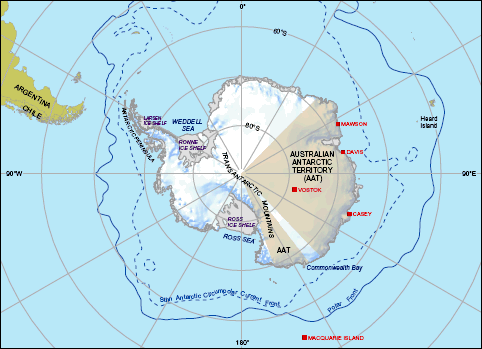AUSTRALIA AND ANTARCTICA
In the 1940s and 1950s national rivalries over activities in Antarctica led to diplomatic negotiations for a treaty governing Antarctic affairs. The International Geophysical Year 1957-1958 provided a positive backdrop to the negotiations, demonstrating that scientists, even from nations taking different sides in the Cold War, could work together amicably in the Antarctic. Australia played a key role in the negotiations that led to the signing of the Antarctic Treaty in 1959 and hosted the first Antarctic Treaty Consultative Meeting in Canberra in 1961.
Given the Cold War context of its negotiation, the Antarctic Treaty is an exceptional agreement. It sets aside Antarctica for peace and science. The Treaty, open to any member of the United Nations, now has 45 States Parties.
The Australian Government and Australian explorers and scientists have had a long and distinguished involvement in the Antarctic continent. The Australian Antarctic Territory covers nearly 5.9 million square kilometres, about 42% of Antarctica and equivalent to nearly 80% of the area of Australia itself. The Australian claim is based on a long historical association with this part of Antarctica. The great Australian explorer Sir Douglas Mawson asserted British sovereignty over this territory, and then in 1933, Britain placed the territory under the authority of the Commonwealth of Australia.
While the Antarctic Treaty was first and foremost a security and demilitarisation agreement, it is now complemented by comprehensive environmental protection through the 1980 Convention on the Conservation of Antarctic Marine Living Resources and the 1991 Madrid Protocol.
Representatives of the nations of the Antarctic Treaty system now gather annually to discuss the management of the area at Antarctic Treaty Consultative Meetings (ATCM). Maintaining the health of this system while preserving Australia's sovereign claim, encouraging and taking advantage of scientific research undertaken on and around the continent, and ensuring the continent’s environmental protection are some of Australia’s principal long-term objectives for Antarctica.
Each year the ATCM and its Committee for Environmental Protection discuss issues facing Antarctica. These include the impact of increasing human activity on the continent, such as tourism, scientific research and infrastructure development, as well as scientific cooperation and operational matters. The ATCM designates areas deserving special protection and management and recently adopted a new instrument that will establish a novel liability regime for activities causing environmental emergencies. The Department of Foreign Affairs and Trade leads the Australian delegation to the ATCM.
Australia has significant scientific and operational involvement in the Antarctic. The Australian Government maintains three permanently occupied stations and shares a summer base with Romania. Australian stations are staffed and supplied by the Australian Government Antarctic Division, which was established in the Department of External Affairs in 1948, and is now part of the Department of the Environment and Heritage.
.
 | Courtesy Australian Government Antarctic Division. |
 Print Page
Print Page
 Print Page
Print Page